区域间互动与区域权力的负相关关系:来自单独静息fMRI和EEG数据集的见解。
IF 2.3
4区 医学
Q2 BIOCHEMICAL RESEARCH METHODS
引用次数: 0
摘要
背景:区域神经反应和网络特性历来是分开研究的。然而,越来越多的证据表明,区域活动和区域间连通性之间存在密切的相互作用。本研究旨在探讨全局功能连通性与区域自发活动之间的关系,即全局与局部的关系:新方法:使用 MOSI 对静息态 fMRI 数据进行分块,从而实现多分辨率功能分区。新方法:使用 MOSI 对静息态 fMRI 数据进行分块,从而实现多分辨率功能分区。对于每个分块群,计算低频波动的平均振幅(节点功率)及其与其余皮层的平均功能连接(节点强度)。相关分析评估了它们之间的关系。对脑电图数据(1-30Hz)进行了补充分析:结果:在核磁共振成像数据集中观察到,节点强度与区域功率之间存在明显的负相关。单样本 t 检验证实了不同 MOSI 分辨率下的稳健性,单个 P 值在 10-4 到 10-5 之间。在脑电图数据中也发现了负相关关系,但仅限于 delta(1-4Hz)和 theta(4-8Hz)频段:本研究引入了两个关键的新方面。首先,它将 MOSI 应用于整个大脑皮层,增强了网络分析的全面性。其次,它研究了对区域神经活动的整体影响,而不是将重点局限于特定网络:结论:在核磁共振成像和脑电图数据集中,始终观察到节点强度和节点功率之间存在稳健的负相关关系,尤其是在较低频段(8Hz 以下)。这些发现为研究全球连通性如何影响区域神经活动提供了一个框架,而抑制性耦合是潜在的内在机制。本文章由计算机程序翻译,如有差异,请以英文原文为准。
Inverse relationship between nodal strength and nodal power: Insights from separate resting fMRI and EEG datasets
Background
Regional neural response and network properties have traditionally been studied separately. However, growing evidence suggests a close interplay between regional activity and inter-regional connectivity. This study aimed to examine the relationship between global functional connectivity and regional spontaneous activity, termed the global-to-local relationship.
New method
Resting-state fMRI data were parcellated using MOSI (modular analysis and similarity measurements), enabling multi-resolution functional partitioning. For each parcellated cluster, the mean amplitude of low-frequency fluctuations (node power) and its average functional connectivity with the remaining cortex (node strength) were computed. Correlation analyses assessed their relationship. A supplementary analysis was conducted on EEG data (1–30 Hz).
Results
A significant negative correlation between node strength and regional power was observed in MRI datasets. One-sample t-tests confirmed robustness across different MOSI resolutions, with individual P values at the level 10−4 to 10−5. The negative relationship was also found in EEG data but was restricted to delta (1–4 Hz) and theta (4–8 Hz) bands.
Comparison with existing methods
This study introduces two key novel aspects. First, it applies MOSI to the entire cortex, enhancing the comprehensiveness of network analysis. Second, it examines the global influence on regional neural activity, rather than limiting the focus to a specific network.
Conclusions
A robust negative relationship between node strength and node power was consistently observed across both MRI and EEG datasets, particularly in lower frequency bands (up to 8 Hz). These findings suggest a framework for investigating how global connectivity shapes regional neural activity, with inhibitory coupling as a potential underlying mechanism.
求助全文
通过发布文献求助,成功后即可免费获取论文全文。
去求助
来源期刊

Journal of Neuroscience Methods
医学-神经科学
CiteScore
7.10
自引率
3.30%
发文量
226
审稿时长
52 days
期刊介绍:
The Journal of Neuroscience Methods publishes papers that describe new methods that are specifically for neuroscience research conducted in invertebrates, vertebrates or in man. Major methodological improvements or important refinements of established neuroscience methods are also considered for publication. The Journal''s Scope includes all aspects of contemporary neuroscience research, including anatomical, behavioural, biochemical, cellular, computational, molecular, invasive and non-invasive imaging, optogenetic, and physiological research investigations.
 求助内容:
求助内容: 应助结果提醒方式:
应助结果提醒方式:


